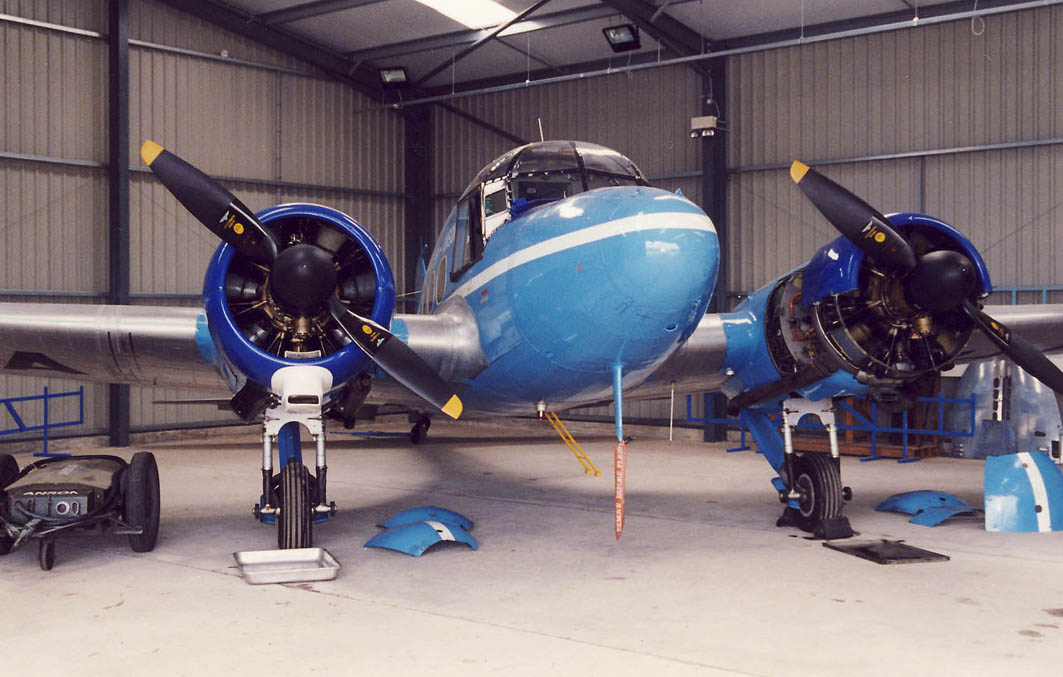
Avro XIX/Anson
 |
| Avro XIX G-AHKX was restored by BAe apprentices at Woodford and now flies from Old Warden |
| The Avro Anson had one of the longest productions of any British
aircraft, with an unbroken run from 1934 to 1952. It began with an Imperial Airways specification sent to AV Roe in 1933 which requested a four-passenger aircraft capable of flying 420 miles at 130mph. In August 1933, designer Roy Chadwick completed plans for the Type 652, a low-wing monoplane with retractable landing gear to be powered by two Armstrong Siddely Cheetah V engines. Imperial ordered two in April 1934 and the first flew on January 7, 1935. The type's order potential received a boost in May 1934 when the Air Ministry notified AV Roe of a requirement for a new coastal reconnaissance type and the company came up with the 652A. The Air Ministry then gave the company less than six months to build the first prototype, which had not yet flown in its civil guise. But AV Roe completed the job and flew its first 652A on March 24, 1935. It differed from the civil version by having rectangular rather than rounded windows and featured a dorsal turret with a Lewis machinegun. The type won the selection competition and the RAF ordered the Anson GR Mk.I, the first flying on December 31, 1935. It entered service with 48 Squadron the following year and 21 units would eventually fly this version in general coastal reconnaissance and search and rescue roles. Exports were achieved to several countries and more than 1,000 had been built by the time World War II broke out in 1939. Many of these were trainer aircraft, and it was in this role that the Anson was to make its greatest contribution to the Allied war effort. The Anson Trainer became the perfect type for prospective bomber pilots and they equipped flying schools in Britain and across the Commonwealth. Total MkI production was 6,742. The type equipped Commonwealth Air Training Plan squadrons in Canada and production shifted there as the situation in Europe deteriorated. Production of this Mk II totalled 1,832, of which 50 were supplied to the USAAF as AT-20 crew trainers. Mk IIIIs and IVs were British-built aircraft fitted out in Canada, and 223 were built. The Mk V featured a moulded plywood fuselage with rounded windows, and 1,050 served as navigation trainers. Production then returned to Britain, with the Mk X featuring a strengthened cabin floor for freight use, and this type served as a crew ferry. The 91 Anson XIs and 254 XIIs featured a raised cabin roofline and three large square windows on either side of the fuselage. With the end of the war in sight, Avro developed the Avro Nineteen for intended airline use and 264 were built, mainly for the RAF as the C.19. The T.20 was a bombing and navigation trainer with a transparent nose and these were sent to Southern Rhodesia. The last major mark was the T.21, the last of which closed the production line in May 1952 after 252 had been built. The last mark was the T.22, with 54 of these radio trainers being built. The type was retired from RAF service in June 1968 and a few fly on with historical operators in Britiain, while a large number of airframes, mainly derelict, can be found in Canada. |
| Contents | Photos | Census | Update |